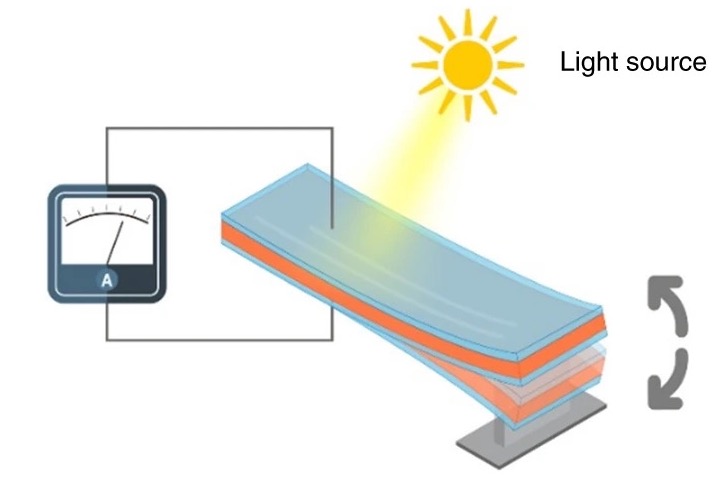A research recently published on Nature Materials, carried out jointly by the Catalan Institute of Nanoscience and Nanotechnology (ICN2), the Institute of Materials Science of Barcelona (ICMAB), Nanchang University (China) and Chongqing University (China), has demonstrated that light can increase by orders of magnitude the electricity produced by bending (flexoelectricity) in semiconductors. This phenomenon, called photoflexoelectricity, allows a single device to harvest energy from multiple environmental sources.

Halide perovskites are a family of materials which are able to efficiently convert light into electricity. For this reason, they have emerged as the golden material for the third-generation solar cells, providing a photovoltaic efficiency of more than 20 %, a result that took decades for silicon to reach. Researchers of the ICN2 Oxide Nanophysics group, led by ICREA Prof. Gustau Catalán, together with colleagues from the Institute of Materials Science of Barcelona (ICMAB, CSIC), from Nanchang University (China) and Chongqing University (China), have demonstrated that halide perovskites besides being efficient photoelectric materials also exhibit flexoelectric properties, which means that a current is generated when they are deformed or bent.
In addition, they have found that the flexoelectricity response of halide perovskites can be strongly boosted by illuminating the material. As explained in a paper recently published on Nature Materials, adding light during bendingallows halide perovskites to generate flexoelectricity orders of magnitude higher than when they are left in the dark, and millions of times bigger than the conventional flexoelectricity of dielectrics.
In this work, the researchers reported on the flexoelectricity measurements of two different halide perovskite materials. They used cantilever-shaped crystals with a capacitor structure (electrode/ halide/electrode), which they clamped on one side, while leaving the other end free to move. With a piezoelectric actuator, an oscillatory force was sent to the free end and the alternating current produced by the oscillatory bending was measured. The experiment was performed both in the dark and under illumination with different light sources. The photo-enhanced flexoelectric coefficients they were able to measure are extraordinarily large, reaching as much as 10.000 % in comparison with those of dielectrics.
Harvesting energy from various clean sources that surround us, from ambient vibration to solar radiation, is crucial for moving towards a carbon-free future. As the authors also show, this photoflexoelectricity phenomenon is not exclusive to halides, but a general property of semiconductors; therefore, it could lead to devices able to harvest energy from multiple sources of input at the same time.
Article Reference:
Longlong Shu, Shanming Ke, Linfeng Fei, Wenbin Huang, Zhiguo Wang, Jinhui Gong, Xiaoning Jiang, Li Wang, Fei Li, Shuijin Lei, Zhenggang Rao, Yangbo Zhou, Ren-Kui Zheng, Xi Yao, Yu Wang, Massimiliano Stengel & Gustau Catalan, Photoflexoelectric effect in halide perovskites, Nat. Mater. (2020). DOI: 10.1038/s41563-020-0659-y

